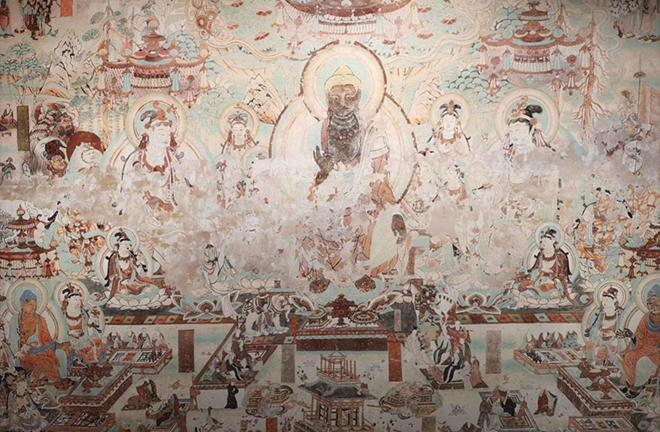Scholars review Dunhuang and Turfan studies

Murals of cave 25 of Yulin Grottoes in Jiuquan, Gansu Province Photo: DUNHUANG ACADEMY
LANZHOU—The International Symposium on the 40th Anniversary of the Founding of the Chinese Association of Dunhuang and Turfan Studies (CADTS) was held in Lanzhou, Gansu Province, on August 17–18. More than 150 experts and scholars from China, Russia, Turkey, and other countries and regions attended the event. The seminar was co-hosted by the CADTS, Lanzhou University, Dunhuang Academy, and Northwest Normal University.
Development of Dunhuang studies
Dunhuang in Gansu and Turfan in Xinjiang have long served as vital transportation arteries along the ancient Silk Road. Over thousands of years, these regions have witnessed extensive commercial, cultural, and civilizational exchanges, resulting in a wealth of historical and cultural heritage. This has given rise to two distinct academic disciplines known as Dunhuang studies and Turfan studies, collectively referred to as Dunhuang and Turfan studies within the Chinese academic community. In 1900, the accidental discovery of the Buddhist sutra cave within the Dunhuang Mogao Grottoes unveiled a treasure trove of 50,000 to 60,000 precious cultural relics. However, due to the limited national strength of the late Qing court (1644–1911), approximately 40,000 of these precious artifacts were lost overseas. Based on research on unearthed documents and grotto art, Dunhuang studies emerged as an “international prestigious discipline” a century ago. However, the dominance of Western scholars in the academic discourse resulted in the perception that “Dunhuang is in China, yet Dunhuang studies are outside of China.” To reverse this situation, the CADTS was formally established in Lanzhou, in 1983, with renowned scholar Ji Xianlin serving as its first president. Since then, Dunhuang and Turfan studies have embarked on a new stage of development.
Dunhuang studies primarily focus on unearthed documents, Han (206 BCE–220 CE) bamboo slips, and other archaeological relics of the Dunhuang grottoes, Buddhist sutra caves, and the north section of Mogao Grottoes. This benefits from Dunhuang’s unique historical and cultural status and influence. As early as 1930, historian Chen Yinque formally put forward the concept of “Dunhuang studies.” In 1986, Ji Xianlin astutely observed that there are four cultural systems in the world that possess extensive historical roots, expansive territories, self-contained structures, and profound influence. These cultural systems are the Chinese, Indian, Greek, and Islamic civilizations. Interestingly, these four cultural systems converge in the regions of Dunhuang and Xinjiang in China. This not only clarified the necessity of establishing Dunhuang studies and Turfan studies as disciplines, but also significantly elevated the Chinese value and global significance of these fields in the realm of ancient cultural exchanges. Subsequently, the rapid academic advancements made in these disciplines have contributed to their transformation into “Dunhuang in China, Dunhuang studies around the world.”
Turfan studies
Turfan studies chiefly center on ancient tombs, city sites, and stone cave temples around Turfan and the cultural relics unearthed at these sites. Despite its relatively later inception compared to Dunhuang studies, Turfan studies possess a wealth of historical and cultural significance, along with profound academic characteristics. Rong Xinjiang, president of the CATDS and Boya chair professor of Peking University, proposed in his article in 2009 that it is necessary to learn from the experience and lessons of Dunhuang studies and intensify Turfan studies in terms of examining and compiling Turfan documents, the regional and social history of Turfan, the history of books in the transcript era, and literature written in the languages of northern and northwestern ethnic minorities along the Silk Road.
Echoing the symposium, the Sixth International Conference on Turfan Studies took place in Turfan on August 21–23. Turfan occupies a unique geographical significance in China’s thousands of years of development. It serves as a vital link between Europe and Asia, bridging the ancient Silk Road and serving as a convergence point of the farming, nomadic, and oasis cultures. It boasts a deep, multi-cultural accumulation of East and West, a widely distributed cultural heritage, rich cultural relic museum collections, and volumes of Turfan documents. These invaluable resources offer substantial materials for the study of the history and culture of the ancient Silk Road.
Over 140 scholars from China, the UK, Germany, and various other countries and regions gathered to present their latest research findings in the field of Turfan studies. These achievements encompass new reflections on Confucian classics, Taoist scriptures, literary works, children’s readings, divination books, as well as various Chinese language documents such as household registration, official certificates, and legal files. They also cover in-depth discussions on transcripts and inscriptions written in Uighur, Syriac, Kuchean, Tibetan, Turkic, Bactrian, Manichean. Research on the history of science and technology was a highlight of the conference, showcasing refreshing archaeobotanical analyses of unearthed relics, as well as the innovative utilization of multi-stable isotope research methods.
Though the loss of Dunhuang cultural relics and documents overseas a century ago is heart-wrenching, thanks to the unremitting efforts made by generations of scholars, especially over the past four decades, China’s Dunhuang and Turfan studies have scored remarkable achievements in major fields, gaining initial academic discourse power and driving the advancement of this niche discipline. This process serves as a testament to the continuous self-improvement of contemporary Chinese academia.
Edited by YANG LANLAN

 PRINT
PRINT CLOSE
CLOSE